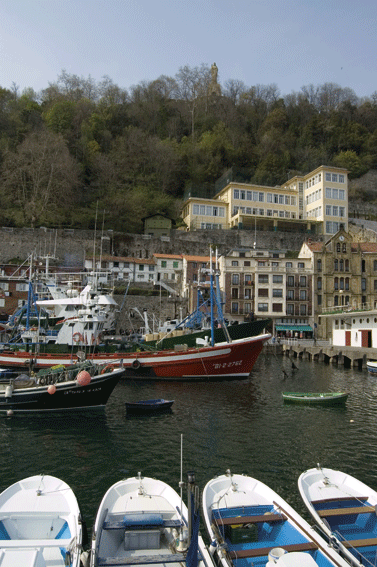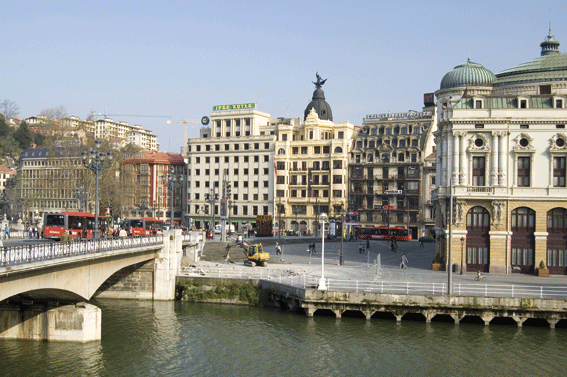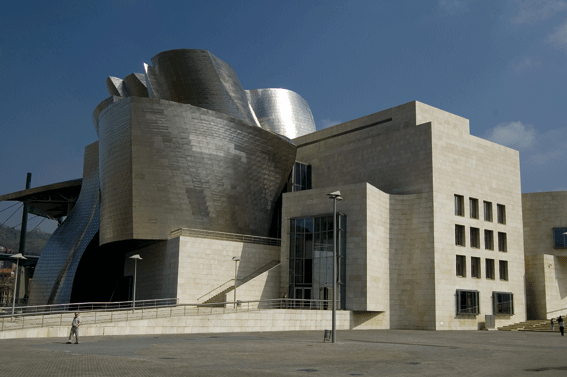
Travel
 Bilbao
Bilbao
Gateway to Basque Country
It is also the leading commercial port of the region, which borders the Bay of Biscay and covers parts of northern Spain and southwest France.
By: Veronica Maria Garbutt
Home to the Guggenheim Museum and something of an international art centre, Bilbao is also the gateway to Basque Country. Bilbao’s uncommon setting, nestling in the green folds of the area’s coastal mountains provides a stark contrast to the smart seaside life of San Sebastian and the economic boom of the Basque capital, Vitoria, Spain’s fastest growing city.
A brief note on Euskadi, as the region is known by the locals. It is composed of Alara, Guipuzcoa and Vizcaya provinces and the native language is Euskara. Wherever you go you will see the red, white and green Basque flag and the people are justifiably proud of their cuisine, regattas and sports such as pelota, cabre tossing, log chopping and tug of war. Cycling too is enormously popular, so if you are driving watch out for droves of cyclists en route.
Now back to Bilbao, known as Boxto in Basque. Originally a scattering of fishing villages on the left bank of a deep river, Bilbao was founded by Diego Lopez de Jaro in 1300. In the same year the settlement was granted city status as medieval Bilboinos conducted their business in Abando wharf and in the Siete Calles district. As business developed the quays grew along to the coast and the city expanded and flourished.
The discovery of the Americas stimulated economic development. Trade grew and industry developed with chemical plants, shipbuilding yards and steelworks. Banks and insurance companies appeared as the dynamo became Spain’s fourth city. It was a golden era as the industrial zone eventually stretched some 10 miles along the Nervion river and its estuary, with smoke stacks and smelters dotting the skyline.
The 1970s collapse of the steel industry saw the grey and polluted juggernaut reinvent itself as a centre of learning, commerce, art and architecture. An ambitious redevelopment programme has seen the rusting machinery of the dock area gentrified. An elegant new metro designed by Sir Norman Foster has opened along with the fabled Guggenheim Museum. A library, park, concert hall, hotel, offices and convention centre have sprung up in the former docklands. But despite its cosmopolitan air, Bilbao’s heart still beats to the rhythm of the cobbled streets of the Casco Viejo, or old town.
In this area Siete Calles is the original block of seven streets of medieval Bilbao. Once encircled by a stone wall, the neighbourhood offers several places of interest. Alight at Casco Viejo metro station and across the arcaded Plaza Nueva to reach the Basque Museum. Inside you can discover the old regional occupations of whaler, fishermen, shepherd, potter and metalworker. Back on Plaza Nueva you can enjoy Tapas (snacks) at Café Bilbao before exploring Mercado de Rivera, Spain’s largest covered market.
Northwest of Casco Viejo lies the striking neo-Baroque Teatro Arriaga which stands at the end of Puente de Arenal bridge. When it opened in 1890 those who could not make it to the performance listened to the inaugural opera over the phone. Today it presents a programme of dance, drama, opera, concerts and zarzuela (light opera Spanish style). This handsome building, inspired by the Paris Opera, is a useful landmark when negotiating your way around the city.
Crossing over the bridge to the right bank you enter the Ensanche, the focus of the city’s expansion in the 19th and 20th centuries. Today the district is the financial hub, home to Bilbao’s stock exchange, BBVA bank headquarters and The Sociedad la Bilbaina, a private social club. Just near the bridge in the unmissable green and yellow façade of the Estacion de Santander while the nearby Plaza Circular has a striking metal and glass entrance to Abando metro. On the shopping train is the fabled El Corte Ingles department store and a must stop for dining in the district is Café Iruna, a Bilbao institution.
If you continue along Lopez de Jaro and into Gran Via you will happen upon the large Doña Casilda de Hurrizar Park beside which is the Museum of Fine Arts. One of Spain’s finest collections, it displays works by Velazquez, El Greco, Goya and Picasso. A collection of Basque works includes works by Zuloaga and Echeverria. Sculptures by Chillida are well represented here too. The park too is a great place to while away an hour or two. Its exotic trees are carefully labelled with a light-and-movement centrepiece – The Cybernetic Fountain.
And so on to Bilbao’s showpiece – the innovative titanium-coated Guggenheim Museum. Worth seeing from all angles, you can’t miss this fantastical swirling structure on the banks of the Nervion. Designed by US architect Frank Gehry, the building was inspired by elements of Bilbao’s past and present economy – the hull of a boat and the anatomy of a fish. It incorporates The Zubizuri bridge and a tram railway line into its futuristic shape.
The building itself is an extraordinary combination of interconnecting shapes. Orthogonal blocks in limestone contrast with curved titanium forms. Glass curtain walls provide light and transparency. The museum’s skylights are not designed to illuminate the artworks, as natural light tends to damage them. The intensity of incoming light is controlled by protective fabric fixed on the glass. For a bird’s eye view of the Guggenheim and the Casco Viejo beyond take the funicular ride from Carretera de Artxanda to the top of Mount Artxanda.
Hourly buses leave Bilbao for Vitoria, a surprising mixture of serious business city and lively student enclave. With the air of a Ruritanian capital, Vitoria, or Gasteiz as it is locally known, has grown to be one of Spain’s modern industrial centres. It has extended itself in concentric rings – in the manner of Amsterdam without the canals – and was named Basque capital in 1980. the city’s charm can be taken in while wandering around the medieval old town and neoclassical commercial district.The old town lies adjacent to the grand Plaza de España and is full of 16th century houses with ornate doorways and coats of arms. On Calle del Herreria lies the Tower of Doña Oxtanta, a medieval defensive tower today home to the Science Museum. Antique shops can be found on Calle Correria which also becomes a lively market on the first Saturday of every month. And for department store aficinados El Corte Ingles lies in the new town centre. The store’s restaurant is also a great place to eat merienda (afternoon tea and snacks) and observe local social life.
Our last port of call on this Basque journey is San Sebastian or Donostia as it is known locally. Forming a half-moon around La Concha bay, the town has been a fashionable resort since Queen Isabel II came to bathe in the sea in 1845. Queen Regent Maria Cristina again made San Sebastian all the rage in 1886 – following the example of Empress Eugenie of France who had popularized nearby Biarritz. It is the home of pintxos (pronounced pinchos) – the most mouth-watering tapas in the world. Think succulent shrimp, blue Cabrales cheese or chicken in béchamel sauce atop fresh crusty baguette pieces.
At the western end of La Concha lies Miramar, Palace of Maria Cristina built as a summerhouse for the royal family. A tunnel under Miramar leads to Playa de Ondaretta, which boasts a chic tennis club and elegant old villas. It is well worth making the trek around the shoreline to see the remarkable El Peine de los Vientos (The Wind Comb) sculptures. This series of bronze structures was built into the rocks under Monte Iguelda by Eduardo Chillida, who was born in San Sebastian in 1924.
Don’t miss the funicular ride up to the funfair atop Monte Igueldo. Back in town you can explore the old town with its atmospheric fishing harbour, check out the Basque Museum and the Naval Museum and perhaps sample the bakery goods and chocolate at Barrenexte. And if you have time be sure to enjoy dinner beside the water at Txulotxo in Pasai San Juan. This seafront village was once home to French author Victor Hugo. Happy journey!